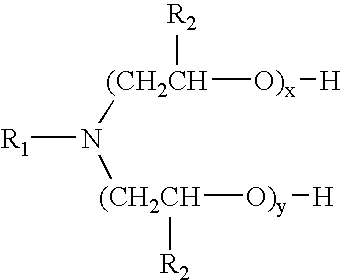Process of making composite sheet material
a composite sheet and material technology, applied in the field of composite sheet material, can solve the problems of reducing the tear strength of shingles made from such shingles, reducing the minimum tear strength of shingles, and ordinary roofing shingles often fall short of this minimum tear strength, so as to achieve the effect of improving the tear resistan
- Summary
- Abstract
- Description
- Claims
- Application Information
AI Technical Summary
Benefits of technology
Problems solved by technology
Method used
Image
Examples
example 1
[0036]Comparative Example 1 was reproduced with the additional step of treating the surface of the resin binder laden glass fiber mat with a fatty acid amide. The fatty acid amide was applied following the application of the resin binder by spraying Armid® HT atop the glass fiber mat in a concentration of 0.5%, by weight, based on the weight of the thermosetting urea formaldehyde binder, which includes 1% carboxylated styrene-butadiene copolymer. Armid® HT, which is hydrogenated tallowalkylamide (tallowamide), was sprayed onto the matrix-laden glass fiber web as a cationic dispersion. The Armid® HT was dispersed in hot water including an ethoxylated fatty alkyl amine surfactant having a chain length ranging from C8–C18. The cationic dispersion was mixed using a high shear rotor and strator mixer and operated at 5,000 rpms. The resultant dispersion had a particle size of 15 μm or less.
[0037]About 8–9 asphalt shinglets were produced in Example 1. These samples were identically tested ...
example 2
[0042]Comparative Example 2 was reproduced with the additional step of spraying the thermosetting resin-laden glass fiber mat with 1% by weight Armid® HT, based on the total polymeric weight of the thermosetting resin matrix. The 1% by weight Armid® HT dispersion was applied as a dispersion in which Armid® HT was dispersed in hot water including an ethoxylated fatty alkyl amine surfactant having a chain length ranging from C8–C18. The cationic dispersion was mixed using a high shear rotor and strator mixer operated at 5,000 rpms. The resultant dispersion had a particle size of 10 μm or less.
[0043]About 8–9 resultant glass fiber mats, which were each 92 g / m2, were identically tested as in Comparative Example 2. The results of these tests are reported in Table 2.
example 3
[0044]Example 2 was identically reproduced but for the dispersant utilized in the 0.1% Armid® HT dispersion. In this example, the dispersant was ethoxylated fatty alkyl amine surfactant having a chain length ranging from C8–C18, produced by Prochem Chemicals Inc.
[0045]The resultant glass mats was treated for tear strength in accordance with ASTM Standard Test Procedure D 3462.
[0046]The results of these examples, encompassing 8–9 samples, are summarized in Table 2.
[0047]
TABLE 2TearTearTensileStrength,Stand.strengthStr.Samples ofgm(f)Deviationincrease %lb(f) / in2Comparative1017118—73.7Ex 2Example 21095143874.3Example 31106158974.0
PUM
| Property | Measurement | Unit |
|---|---|---|
| concentration | aaaaa | aaaaa |
| concentration | aaaaa | aaaaa |
| concentration | aaaaa | aaaaa |
Abstract
Description
Claims
Application Information
 Login to View More
Login to View More - R&D
- Intellectual Property
- Life Sciences
- Materials
- Tech Scout
- Unparalleled Data Quality
- Higher Quality Content
- 60% Fewer Hallucinations
Browse by: Latest US Patents, China's latest patents, Technical Efficacy Thesaurus, Application Domain, Technology Topic, Popular Technical Reports.
© 2025 PatSnap. All rights reserved.Legal|Privacy policy|Modern Slavery Act Transparency Statement|Sitemap|About US| Contact US: help@patsnap.com

